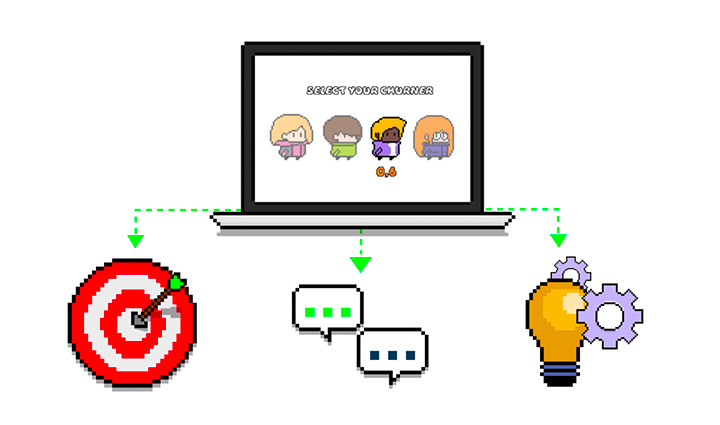Everything you need to know about user retention for gaming apps
Across the board, gaming apps lead the charge when it comes to app retargeting. App marketers in gaming are very savvy when it comes to what retargeting is, and how it is essential for app growth.
But just as a refresher, retargeting is a crucial aspect of user retention for gaming apps. It allows marketers to re-engage users who have shown interest in the app to keep them active. By targeting these users with personalized messages, incentives, and promotions, marketers can encourage them to return to the app and continue playing. Retargeting can also be used to upsell to existing users, encouraging them to spend more money in the app. Additionally, retargeting can help marketers to identify and address potential pain points or issues that may be causing users to abandon the app, allowing them to make improvements and increase user satisfaction. Overall, retargeting is an essential tool for gaming app growth marketing because it can help to increase user engagement, reduce churn, and drive long-term revenue.
Although each app is different, there are a couple different strategies that usually work well for gaming apps.
The first is targeting active users. It may seem counterintuitive, but when faced with the fact that the average app has a 6% retention rate, app marketers should know that active users may not remain active forever, or even for long. By retargeting these users as soon as day 0 or day 1 after install, marketers can start maximizing their LTV early and investing in their in-app longevity.
The second is targeting payers. Payers are users who make or have made in-app purchases. For many gaming apps, especially mid-core and hardcore gaming apps, this group of users drives the majority of in-app revenue. As these users have already shown that they are willing to make in-app purchases, it’s highly likely that they’ll continue to do so given the right encouragement. We’ve found that in some cases 64% of users who make a first purchase go on to make repeat purchases, making retargeting especially valuable for this user segment.
Targeting payers is also a great way to measure incrementality. By measuring incremental uplift before, during and after the retargeting campaign, app marketers can get a clearer sense of how many of those users did indeed return to make a purchase, and whether or not it had a significant impact on in-app revenue. As we mentioned, many gaming apps are reliant on a small group of high paying users. By targeting high value payers and measuring their impact over time, marketers will know for certain whether or not their efforts are paying off.

By far one of the biggest pain points for app marketers is user churn. Users have so many apps on their phones that marketers must stand out in a big way to capture their attention long term.
Predicting churn at segment level allows marketers to deploy targeted strategies to increase user retention. Combined with retention strategies such as retargeting, cross-promotion, push notifications, and others, user churn prediction allows for data-driven decision making about which users are important to the app’s growth.
Leveraging user churn prediction algorithms developed by Adikteev can:
- Improve targeted retention strategies to reduce churn
- Help boost user LTV by identifying and targeting users at risk of leaving
- Lead to lower UA costs as more and more users are remaining in the app
- Increase app marketers’ ability to foresee and respond to changes in user behavior or market trends
- Allow for more confident decision making thanks to data-driven insights
By having more visibility over which users are likely to churn, marketers can protect the small group of users who drive the majority of in-app revenue.
Machine learning models analyze an app audience, and score users for churn prediction probability. Users with a high probability of churn are put into an audience segment and can be targeted for remarketing activities.
The data from the algorithms can be applied to a variety of user retention strategies.
App developers can use churn prediction models to see if there are any weak points in the app. For example, the product team notices that the overall user churn score is lower after a specific point in the app. They are able to look into what’s going on at that moment to cause users to leave. It can also help in developing a pricing strategy that is both lucrative for the developer and acceptable for the user: if the developer raises the price of certain items and sees the user churn score drop significantly, it’s clear that this pricing strategy isn’t working out and should be adjusted.
By using churn algorithms to segment about-to-churn users, marketers can target them through CRM messaging to keep them active. This could include promoting new features, offering discounts, or any other in-app action that’s been proven to encourage users to stay active.
App marketers can leverage channels such as
- push notifications
- emailing
- in app messages

Like for CRM and owned media, marketers can use data from churn prediction models to segment and target users for paid media like retargeting or cross-promotion. This can be either to keep users active within the same app (retargeting) or move them to a new app within the same portfolio (cross-promotion).
Gaming apps have always been at the cutting edge of adtech. User churn prediction algorithms, retargeting, and cross-promotion are powerful tools that can greatly improve their user retention strategies. By predicting user behavior and offering personalized recommendations, gaming companies can effectively reduce churn and retain users. Retargeting campaigns can also help to re-engage users who have left the app, while cross-promotion can introduce users to other games that they may be interested in. These strategies require a data-driven approach and careful analysis of user behavior, but when implemented effectively, they can lead to increased user engagement, higher retention rates, and ultimately, greater success for gaming app developers.
RETAIN YOUR BEST PLAYERS
Predict, Prevent and Retain with Adikteev
.png?width=200&height=52&name=Adikteev-H-White%20(1).png)
